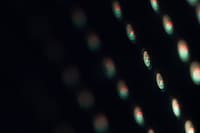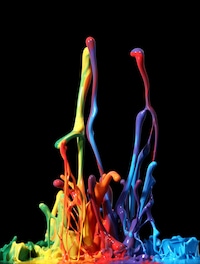
A 19th century painting

1.7 million pixels

13 mixing colors

We know the power of color
As a paint company we know how important it is to be able to get just the right color – for your walls at home or repairing your car, for example. Our current technology allows us to identify, mix and apply colors very accurately, and that’s actually a very powerful thing.
We first made the connection with the Van Gogh Museum in 2013, providing paint for the new wing and partnering with their restoration studio. I joined the team of conservators, researchers, microscopists and art historians to see how AkzoNobel could help preserve Vincent van Gogh’s heritage, starting with the painting Field with Irises near Arles.

The digital restoration process
Together with a researcher in my color innovation team, Ivo van der Lans, we discussed how we might be able to use our existing technology. And it turns out that with minor adjustments, the very same computer program our department had developed for the automotive industry could also be used to digitally recreate the painting’s colors.
I should explain that this process was quite different from the traditional restoration work done on this painting. That’s the painstaking process of using cotton swabs to remove old and discoloured varnish. But pigments also fade or change color over time, like the yellows and reds in this painting. Those color changes are not fixed without touching up the original paint, which would not be a good idea. So instead, we thought about how we could digitally recreate the painting as Van Gogh most probably had painted it.
To begin, a scientist from Washington’s National Gallery, John Delaney, recorded a hyperspectral image of the painting. A special camera then precisely measured the color on all 1.7 million pixels of the photo. Based on those color measurements, and using our AkzoNobel color software, Ivo and I calculated the paint mixtures for every single pixel.
Innovative technology
That was an important milestone in the project. Nobody had done exactly this before. We studied other researchers who calculated the original colors of other Van Gogh paintings. But technology has already moved so fast that for this painting we were able to measure more colors more precisely, and make the color calculations faster than ever before. Previous projects made as many as 50 detailed color calculations – now, it was possible for us to do 1.7 million.
And that’s not all we did for the first time. We investigated all thirteen mixing colors Van Gogh used for this painting and either used the same process to produce the paint or used pigments that best imitate the actual paints he used. We were the first to do this for all the pigments in a painting – and it made this restoration as true to the original as possible.
But still, recreating some colors was a challenge. For example, our initial calculations indicated the sky had been very green, which didn’t seem quite right. Our program had assumed a green pigment in the sky to be the same as in the landscape, as this had been concluded from microscope studies on the painting. But since our initial calculations gave these unexpected results, conservation specialist Muriel Geldof did some more microscopic studies on the sky part of the painting, and she then discovered an entirely different type of green pigment was present there which had been overlooked before. Another example of what’s possible with a multi-disciplinary team.
I’ve learned that Van Gogh was always testing new ideas and color concepts. And as part of the Color Technology Group, I realized I do those same things today. For example, when new color sensors appear in smartphones, we think of ways to utilize them. And when new types of car paints appear on the market, we investigate how people perceive those paints. That’s similar to how Van Gogh always tried to find out how his colors looked like in his paintings, instead of just trying to apply the “true color”. Diverse fields of expertise can intersect in such interesting and world-altering ways.

Curious about digital art restorations?
We have recently developed the iColorDesign app on Apple’s app store to help architects and designers browse through the latest design trends, and develop color and effect combinations.




